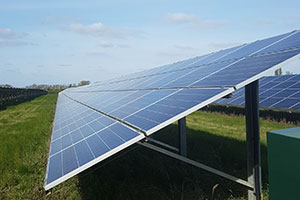How renewable energy can assist farmers with future economic plans
There’s no escaping the fact that farmers are having to work harder than ever to boost their bottom line. And, with trying times looking set to continue as Brexit looms closer, there are ways to unlock the value of farmland – without having to sacrifice your way of life.
It’s not always necessary to simply sell land in its entirety to the highest bidder. As renewable energy continues to play a major role in farm diversification, Dave Ogden, director at electrical contractor, Smith Brothers Ltd, explains how green power is assisting farmers with their future economic plans.
Historically, arable farmland would be home to row-upon-row of neatly organised crops. But now, the grid format is increasingly being adopted by an expanse of solar panels, generating electricity for use on site. Similarly, it isn’t uncommon to see cattle grazing beneath the blades of a wind turbine.
On-farm renewable energy undoubtedly aids the cost of day-to-day operations – and generating your own heat and electricity is an attractive proposition – but it can also create an additional revenue stream for farmers who export their unused power to the grid.
What’s stopping you?
Plenty of farmers already rely on biomass fuel to produce heat for their buildings, but one of the main barriers for the implementation of other forms of renewable technology, is the perceived initial setup cost of clean energy vs. that of fossil fuels.
In recent years though, the initial outlay associated with utility-scale wind and solar facilities has declined significantly. As the cost of the engineering equipment itself – such as photovoltaic panels and steel – is starting to come down, and the co-location of technologies is being encouraged, the renewables sector looks set to flourish.
While many landowners may be reluctant to sacrifice acres of land for anything other than animals or crops, a sustainable farming future – which will last for generations – is demanding the potential value of the land to be unlocked.
But how do I know if my land is suitable?
Most investors will look for land close to priority connections. Smith Brothers – for example – will take different calculations from information supplied by DNO’s in order to establish the capacity available on the network.
To help farmers make decisions over how to use the space they own, the Agricultural Land Classification (ALC) provides a framework for classifying land and evaluates physical or chemical characteristics which could impose long-term limitations on agricultural use.
Typically, any land which is ranked from subgrade 3b to 5 will have limitations surrounding its suitability for various farming activities, but would be an area of interest for renewable development. Firms would look to purchase the farmland directly from the owner, applying for planning consent and grid connections themselves.
This can be a hugely attractive proposition, as planning permission for renewable sites can often be tricky – particularly in rural areas where the local community are against construction on picturesque landscapes.
For landowners who want to maintain ownership of their land and make the most of the renewables market, this is another option, as it’s possible to  combine both income streams on one piece of land.
combine both income streams on one piece of land.
Divide and conquer
One option that’s proving popular with livestock owners, is the co-location of infrastructure.
Wind farms can share their field with livestock, while solar panels can be located on stilts, high above the crops below, but still allowing both to harvest the sun’s rays. The opportunity to enjoy the ‘best of both worlds’ is one which fledgling renewable farmers are considering more frequently.
While it’s all-too-easy to shy away from change, in troubling times, diversification can help transform a struggling business, simply by complementing the existing land and infrastructure with a secondary revenue stream.
- Log in to post comments

